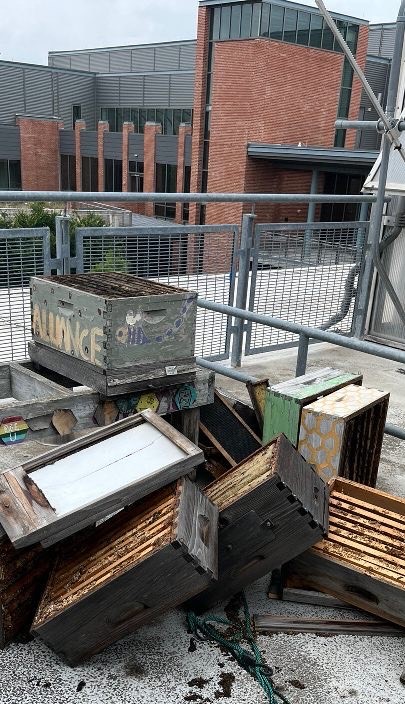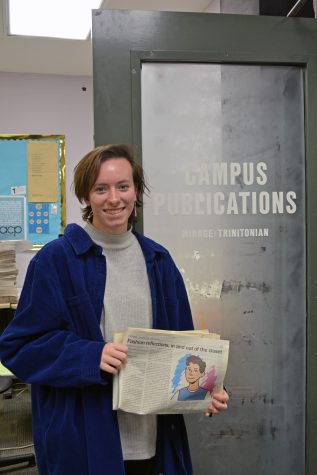Guest Column: Trinity’s red bricks are greenwashed
What campus looks like without a sustainability coordinator position
Current state of beehives on top of CSI
Generation Z recognizes climate change as a serious threat. We have been taught since elementary school that greenhouse gasses cause sea levels to rise and a more severe climate. We recognize the climate crisis and we experience “environmental anxiety.” But what are we and our university actually doing about it?
A recent article in the Trinitonian addressed the termination of Sharon Curry, former sustainability coordinator. This article should have been about the thoughtless elimination of the position but instead wrongly painted Trinity as a trailblazing sustainability-minded school. The sustainability coordinator was Trinity’s environmental compass and, at the time of elimination, was the only position dedicated to sustainability. It ensured our success in AASHE (The Association for the Advancement of Sustainability in Higher Education) and STARS (The Sustainability Tracking, Assessment & Rating System) compliance, access to energy usage information, recycling, physical plant coordination and wildlife management (e.g., bird strikes). It supported the environmental studies senior capstone, the Gardening in South Texas course and student initiatives like EcoAllies. While the campus architect is also “Director of Sustainability,” he cannot do these tasks in addition to his job; indeed, the loss of this highly integrated staff position signals the ultimate degradation of Trinity’s commitment to sustainability.
The same article also lauded Trinity’s implementation of water recycling in landscaping 22 years ago, but what comprehensive water-reducing initiatives have been taken since then? While lawns are valuable spaces for congregation, only a handful are necessary. A status symbol from 17th century England, lawns are out of place and out of touch with the current climate of south Texas. Fewer lawns would reduce water use, harmful pollutants from gasoline powered machinery and save money. Xeriscaping, landscaping with native and climate-ready plants, would be cheaper, more efficient and more sustainable. Trinity still plants non-natives, and even invasive species throughout campus including nandina, lantana and African irises. Few natural, green spaces remain to reflect in nature, despite solid research proving that green spaces are vital for mental, physical and emotional wellbeing.
The Center for the Sciences and Innovation’s Gold LEED certification, a globally recognized symbol of sustainability achievement, is touted as proof of Trinity’s sustainability efforts. Among many environmentally friendly features, one is its green roof on the fourth floor. Home to Texas native grasses, this green space provided food for pollinators and seed foragers, teaching tools for biology classes and study space for students. The water pump broke in 2020 and no efforts have been made to restore water or save the grasses. These beautiful grasses are resilient but no match for two years without water combined with winter storm Uri and extended drought. This former gem is now a dry, crunchy mass — a brown roof. This trend is similar to the deterioration of the CSI beehives on the fifth floor, which have been abandoned and rotting since 2020. True to form, the latest issue of Trinity magazine showcased the honey bee project.
Trinity’s new pride and joy, Dicke Hall, will not receive LEED certification. Though the building would need few additions to achieve LEED status, there apparently wasn’t enough of the million-dollar endowment to commit to environmental protection and progress. There is no word yet on whether other buildings in the campus master plan are set to be green.
Trinity has risen in the ranks of top private liberal arts colleges in the U.S. However, we stand apart from similar universities as one of the few with no climate plan. It is impossible for Trinity to compete and improve their standing without committing to sustainability. This inaction also affects our ability to recruit future first-year students, 74% of which base their university choice on their commitment to sustainability (Princeton Review). How can we as a university promise to become better stewards when we have no plan for improvement? John Scherding, our campus architect, recognized this in the previous article, but, in light of the dissolved sustainability position, will he be empowered to make this change?
Trinity has a responsibility to become more sustainable, simply because it’s the right thing to do. As an academic institution that claims to put students first, it should build a better future. And if those reasons aren’t enough, it should at least improve its environmental policies to attract new, prospective students, who understand the existential crisis of the planet and want to do something about it.








Paula Hertel • Oct 7, 2022 at 9:37 am
Thanks for this important article. There is so much to do that requires only moderate effort, but we cannot even find ways to keep the plastic cups out of the trashcans.